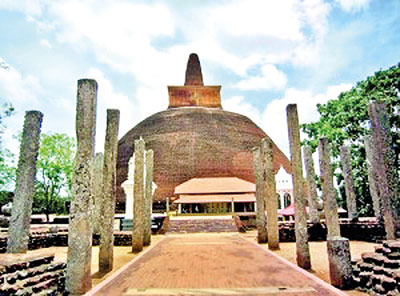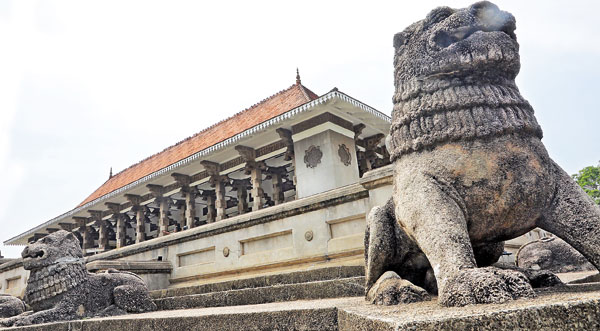75th Independence
Time to look beyond the colonized mind
View(s):- Can we celebrate an architecture of independence, asks Dr Shanti Jayewardene
Early in the 20th century, J.P. Lewis, the Irish civil servant and colonial intellectual, remarked on the lamentable impact the government’s policy was having on native architecture whereby, ‘old and artistic Kandyan work is being removed and replaced by nondescript and hideous, modern work after the style of the petty masons and contractors of the low country’.
The low country Lewis jeers at had been under European rule since the 16th century, albeit with contested territorial boundaries. The Kandyan zone came under secure British rule following the so-called Rebellion of 1848. So what do we make of Lewis’ lament?
We know little of the built landscape of the interior of the country at the time the British began their long 60 years of war to completely subjugate the people of this region. Why did they intervene so massively to transform the entire building organization? Between 1800 and 1900 they institutionalized a State monopoly of building and undermined the intellectual culture of architecture.

Restoration of Abhayagiri dagoba: Intangible heritage questions in ancient living sites
Can we even remotely conjure up those precolonial urban rural landscapes of exquisite forests, rivers, lakes, rice-fields, flower gardens and orchards, emerging from the Sandesas, and read them in conjunction with British records of cold, misty, forested mountains and open plains where large herds of deer, elephant, buffalo and wild boar roamed? Can we begin to give life to those people within the urban cores, and others who dwelt in the hinterlands be they craftsmen, farmers, fisher folk, hunters or nomads who tended their lands, herds of cattle and managed their trans-basin irrigated landscapes at the time of conquest? Is it useful to think about how they designed and built prior to subjugation? Does it matter? Let us skim the practical or material interface where imported knowledge systems collided with those diverse knowledge systems and practices in place.
The powerful Ceylon Public Works Department (PWD) created in 1796 was a colonial institution with no counterpart in Britain. It facilitated conquest, united the conquered lands physically and enabled construction of the myth of a united nation state. The PWD assisted colonial armies move, dispossess, govern and transfer extracted resources to the coast for shipment to the motherland. When aristocrats and nobles were brutally deprived of their land, wealth and titles, native architects and engineers lost patronage. Existing building systems were dismantled as powerful alien patrons of architecture upheld the view that European knowledge was superior to native knowledge.
The merry band of men, who would eventually lead the PWD, were in search of employment, across expanding European empires. They came primarily from Scotland and Ireland, untrained, or with a modicum of apprenticeship. Potential rookie technocrats with no local knowledge, supervised state construction – from ports, police stations, markets and prisons to hospitals and schools among others. They needed native knowledge to function and they learned from native experts. Unequal intellectual collaboration between colonizer and the colonized was a generic feature of knowledge collection in the colonies.
By the late 18th century Europe witnessed the emergence of a few engineering/ architecture schools. In India, for instance, the first engineering school on the European model came about in the 1840s. At the same time, Europe was beginning to send overseas, men, equipped with new, allegedly superior ‘scientific’ knowledge. Since Europeans competed with natives for their jobs, men who thought like Lewis were a minority. The European ‘civilizing mission’ narrative, premised on the construction of a poor subject people with a glorious past, was instilled in the minds of colonizer and colonized alike. Finely tuned, it tenaciously lingers.
Modern architecture in Ceylon blossomed under the purview of engineers, while the first PWD Architect, J.G. Smither, appointed in 1865, also served in the Archaeology Department. His task was to consolidate the myth of the glorious past against a dying architectural present. The colonial story of architecture splendidly revealed, through measured drawings and English text, the glorious ruins at Anuradhapura. Smither’s native assistants almost vanished in the magisterial collaborative tome, published by the government in 1895. The conqueror was replacing the native intellectual as the knowledge maker.
A decree restricting access to higher echelons of the PWD, to those with European qualifications, registers a more violent exercise of power. The Ceylonese intellectual is becoming a ‘conscript of modernity’ precisely because violence was woven into the fabric of the colonizer’s mind. The colonized mind, born of this violence, is equally unfree. Local architects, engineers or equivalent specialists, who had designed and built all of Ceylon’s extensive engineering works up until then, were displaced or absorbed into the second tier of the PWD.
By 1900, mixed race persons were singled out, for training in state technical colleges, to serve in the lower strata of the government technical cadre. The production of a technical cadre in architecture, looking towards Europe for knowledge, had begun. Ceylon’s modern architecture of the 20th century was naturally a jumbled, largely PWD affair until natives, trained in UK, India and Australia, began returning home in the 1940s, equipped with new knowledge.
Exciting as was this search for modern knowledge from the colonizer world, it concealed a darker side – the violence of ‘coloniality’ (a term used by Walter Mignolo). In chasing the west, we almost lost our ability to think independently. We became trapped in the epistemes of our rulers. All our minds, colonized to some extent, are unfree.
The Portuguese introduction of European classical architecture for official buildings was accompanied by an indigenizing strain in domestic architecture, that was further differentiated by Dutch rulers and cosmopolitan natives. The colonial state’s Parliament building, in 1920s Colombo, was a resolutely neo-Baroque, Classical monument, proclaiming British power.

The Independence Monument built by Wynne Jones
The former colonized native rulers, however, announced their unequivocal rejection of Classical colonial architecture in 1953, when they commissioned in Colombo, a peculiar monument to independence that stoutly mimicked the timbered Audience Hall of Kandyan Kings. The new political elites’ wish was articulated in the designs by PWD Chief, the Welshman, Wynne Jones.
The Independence Monument brought, to Lewis’ low country, the symbolic power of indigenous royalty, annihilated by the British. In 1860s India, British proconsuls commissioned PWD architect, Robert Chisholm, to design a landmark building, the Senate House, University of Madras, in a hybrid European, Deccani, Madurai mode. Seen in this light, the designs with a Buddhist veneer, prepared for the University of Peradeniya campus, 80 years later by Shirley de Alwis, can be seen as responding to the overlapping predilections of Ceylon’s nationalists and enlightened British intellectuals. This exchange interface illustrates how an unequal sharing of knowledge emerged in a colonial architecture discourse.
Having digressed to set the long duration of the historical context of colonial knowledge making, I shift back to the main theme of looking at how knowledge of modern architecture is made today. From inception, in the 12th century, or earlier, Colombo was a plural, indigenized urban form, home to many ethnicities – African, Chinese, Hindu, Christian, Muslim peoples, speaking numerous languages including Tamil, Persian, Sinhala, Mandarin and Portuguese. On the broader pedagogic front it is thought that the two Pirivena schools of Vidyodaya and Vidyalankara of the 1870s, challenged the dominance of missionary education in Colombo and that secular teaching in Buddhist schools began soon after. The architectural decoration of the latter, with Buddhist motifs, followed pirivena precedent ultimately supervised by the Malwatte Chapter in Kandy.
Some believe that by 1948, government buildings were ‘decolonized’ by Ceylonese architects, returning from abroad, who also advocated a Buddhist decorative veneer. The same group was responsible for establishing the first school of architecture in 1961, initiated after independence in Colombo, its pedagogy and format taken from University College London. We now have four schools of architecture, three university faculties and several private schools of engineering where reflexive thought and a theoretical discourse engaging the history of modern architecture or engineering and the construction of knowledge is rarely seen.
While India had the JJ School of Architecture by 1911, it too was modelled on European precedent. Decolonization was not on the agenda. Recently, Mustansir Dalvi, head of the JJ School, writes that ‘This New Architecture’, produced in Mumbai from the 1920s, is a home-grown modernism. It grew within the colonial discourse and not under the auspices of the European Masters who designed Nehru’s dream of independence and modernism in Chandigarh. The Indian discourse is not taught here.
The mainstream Bawa narrative operates within a descriptive ‘tropical modernist’ European discursive trend, carefully insulated from deeper currents of colonial violence and the struggle for independence. That Bawa’s work might have engaged in a politically aware quest for indigenous knowledge is ignored. The anti-Bawa drift in architecture circles is founded on a historical mainstream pedagogy inclining towards copy-paste, digital modernist, problem solving, ‘scientific’, knowledge systems in architecture schools. The current pedagogy preserves Euro-American dominance.
In the context of independence and knowledge making, Professor of Archaeology, Jagath Weerasinghe, remarked in 2016 that the relationship between history (Mahavamsa as the authoritative source of knowledge) and archaeology has established ‘a seriously flawed notion that the past is synonymous with history’. In architecture schools too, the past is regarded as synonymous with history. The flaw conceals the relevance of the history of modern architecture to contemporary architectural practice. It denies history a vibrant discursive theoretical connection with design. Students have no exposure to the politics of knowledge-making during colonial occupation and believe the narrative that modern Euro-American knowledge in architecture is both objective and scientific. Untrained in reflexive thinking, their world is circumscribed by Eurocentric theory.
Weerasinghe further remarks that ‘the outdated belief, that what archaeologists do is scientific method’, is a limiting factor that prevents engagement with archaeology as a critical discourse, where archaeology is seen as a discursive formation that requires a critical practice. He comments that restoration of the Abhayagiri stupa controversy, ongoing from the 1980s, presents an extreme case of ‘internationalism’ gone wild, where the heritage experts refused permission for the stupa to be plastered in white. Whereas, the modernizing at Dambulla is a case of ‘indigenism’ gone wild. The examples illustrate the inability of archaeologists to engage in archaeology as a critical practice because their thinking is framed by international (UNESCO) guidelines of 1972 that deal with ‘authenticity’ as defined in Europe, leaving little room for intangible heritage questions arising in ancient living sites.
Sri Lanka’s archaeologists were unwilling to abandon a European discourse on authenticity, that uncritically serves nationalists and racial nationalism after independence from occupation. The heritage expert refused to break with colonial knowledge. But the monk at Dambulla, also in tune with international currents of thinking on intangible heritage, gave his devotees an indigenized invention of the past irreverent to internationalism. Weerasinghe suggests that a critical archaeology practice has the power to produce a more balanced outcome between such extremes. To date, the stupa is unplastered!
It is exciting to imagine a scenario that goes beyond the bounds of extreme duality where students, grounded in the historical knowledge of their own architecture, could develop an architectural pedagogy of sharing knowledge with their Euro- American counterparts, where sharing is founded on equity and mutual respect. For this to become a reality, we would need anti-colonial practices, as articulated by British archaeologist, Dan Hicks, to be developed by the colonized and colonizer.
(The writer is an architect, architectural historian and independent researcher living in Colombo. She was trained at Moratuwa University, University College London and the University of Oxford. Her published works include several articles and two books; Imperial Conversations: Indo-Britons and the architecture of South India(New Delhi, 2007) and Geoffrey Manning Bawa: Decolonizing Architecture (Colombo, 2017). She is presently collaborating with a Swiss team on a book on the ancient gardens of Sri Lanka, due for publication in Milan later this year)

